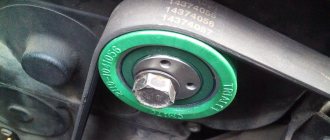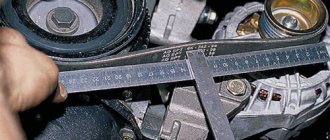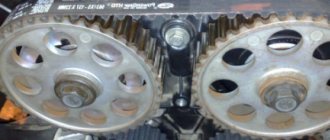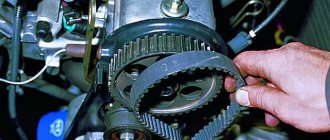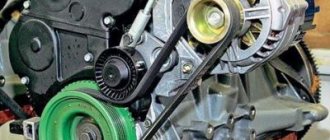The VAZ-2112 engine was installed on LADA cars of the “tenth” family: 2110, 2111 and 2112. Two timing shafts in this engine are driven by a belt. When replacing a belt, you need to be able to control the tension, and it seems that special equipment is produced for this. We believe that tensioning the timing belt on a VAZ-2112 can be done using a dynamometer. In this case, the tension force can be set without errors. You just need to make a technological plate used instead of a tension wrench. The drawing will be given below.
The following video shows how exactly the tension is checked, without even using a dynamometer.
Then, replacing the timing rollers and correct belt adjustment
Happy Monday everyone, from the moment I bought the car I immediately changed the belt and rollers to new ones.
But today I have already driven 23 thousand km and therefore my hands and head were itching to change the rollers and adjust the timing belt tension. I took the old rollers that were removed from the machine to replace new rollers, but as it turned out, the rollers were wear-free, only there was no lubrication, so I washed and filled them with fresh and recommended lubricant for rollers TOTAL ALTIS SH2: High-temperature lubricant and voila, the rollers were just like from the store. There were no problems with installation and adjustment; I made a special device to check the belt tension, as well as a clamp for the camshaft gears. The old rollers that were removed were really worn out—they felt loose when held in the hands. I adjusted everything as it should, not according to the Murzilka, but according to this entry from the site www.autolada.ru/viewtopic.php?t=101198&start=125 and verified by me, you write obvious things known to everyone. bboyan Have you seen the technique proposed by VAZ? “When applying pressure with a force of 10 kgf on a belt with a tool 3 mm wide, it should bend by 5.2-5.6 mm. The adjustment is carried out on a cold engine." The creator of such methods should be shot. Firstly, catching tenths of a millimeter while hunched over the engine is extremely inconvenient, secondly, this technique definitely leads to overtightening, thirdly, 99% of service stations do not use any devices at all when tensioning the belt, and fourthly, the design of the 1.5 engine itself is not enough calculated for the shock loads of the belt (IMHO, for example, during engine braking with a sharp downshift), so a derated 1.6 engine appeared - the capitulation of VAZ designers to a belt that was “difficult” for them to understand. The complex of these problems leads to the accelerated demise of the belt; I get the impression that it cannot be tensioned correctly at all. And all this is aggravated by the colossal number of fakes.
You need to tighten or loosen it a little, just 2-3 degrees on the tension wrench. I personally tighten it when the belt hits the casing during a cold start. Immediately turn it off, tighten it 2-3 degrees - and the belt no longer hits. If it still hits, we give it another 2-3 degrees of tightening. If you remove the cover and turn the engine by the wheel in 5th gear, then at some point the belt becomes a hump between the pulleys. This hump is what knocks on the casing, and it needs to be removed. I personally adjusted the belt correctly on the 6th attempt, as they say, measure seven times and cut once!
Source
Installation diagram and purpose of the VAZ 2114 alternator belt
Since the engine installation on the VAZ 2114 is transverse, then the VAZ 2114 alternator belt is located on the right side of the car or on the left side of the engine, if you look there with the hood open, not familiar with the cooling radiator.
At the end of the crankshaft opposite the flywheel there is a timing belt drive pulley, which spins the camshaft and oil pump shafts with a pump, as well as the electric generator drive pulley. The timing drive is covered by a plastic cover, and the belt drive runs outside, on top of this cover, and connects the electric generator drive pulley on the crankshaft to the alternator pulley. On the VAZ 2114 there is no belt tensioner pulley, like on the VAZ 2110. Tensioning the alternator belt is done using a different method.
The belt drive is marked 21082-3701720 and when selecting it you need to find a belt with a length of 698 mm. During the use of the machine, the myth drive is exposed to severe loads, not only mechanical, but also thermal and chemical. Therefore, the highest demands must be placed on the quality of the belt drive. Probably experts and car owners advise using belts of the “BOSCH” brand, also called “GATES”. Although their cost is about 500 - 550 rubles, versus 200 - 300 rubles for products from a Russian manufacturer, the quality of these drives is significantly higher.
Replacing the timing belt 16 cl. engine
Replacing the timing belt VAZ 2112 1.6 16 cl.
1. Remove the timing belt protection. The timing belt guard is secured with six bolts. Remove the chip from the crankshaft sensor, unscrew one bolt and remove the sensor.
2. One tooth is missing on the pulley, this is not without reason, this allows the crankshaft sensor to determine the top dead center, and also allows you to block the crankshaft in order to unscrew and tighten the pulley mounting bolt.
3. This is done like this: the pulley is aligned with the hole for the crankshaft sensor and through the hole for the sensor, a suitable size tube or other suitable object is inserted, in my case it is a hexagon, the pulley is blocked, and then unscrewed and removed.
4. Loosen the tension roller nut and remove the old timing belt.
5. Install a new belt, the belt can be installed by turning the right camshaft with a wrench, or you can remove the tension roller, whichever is more convenient for you.
6. Tighten the pulley mounting bolt back and align the timing belt drive gear according to the marks. If there are no marks on the oil pump housing, put marks on the flywheel and, using a chisel, make a mark on the oil pump, this will be more convenient.
7. Align the marks of the camshaft pulleys so that the timing belt drive gear does not go astray
8. Using a special wrench, tighten the belt with a tension roller. If there is no key, don’t be upset, you can tighten it with two nails and a screwdriver between them, or you can take a steel fork, remove the two middle teeth completely, and shorten the two outer ones in half and bend them. Be sure to remember to tighten the tension pulley nut. (To tighten the belt, turn the tension roller counterclockwise (about 10–15°); to loosen it, turn it clockwise)
9. Turn the crankshaft two full turns and check the marks; if all three marks match, put the pulley in place, do not forget about the generator belt and crankshaft sensor, then the belt protection and you can start the engine.
Timing belt tension
1. Check the belt tension. A correctly tensioned belt should rotate 90° from finger force (1.5–2 kgf) in the middle between the crankshaft and camshaft pulleys.
2. I take it with two fingers between the camshafts and up and down. 5-6 mm fluctuates back and forth, then I leave it.
3. Adjust the timing belt tension using a special device. The most correct belt tension is 2 kGs. Having achieved this result, fasten the fastening nut.
4. In the "Manual", the manual verification method is described in detail. It involves checking the tension of the toothed belt in the middle part of the branch between the camshaft pulleys. It should be such that under the action of an object 3 mm wide with a force of 10 kg, the belt deflection is 5.4 mm. Deviations in any direction are allowed no more than 0.2 mm. The engine must be at “room” temperature (+15-30°C). An overtightened belt breaks - the strength of the cord threads is limited. And the tighter the belt is, the faster the threads will break. A loose belt will also not last long, because... when entering the pulley, the belt teeth do not fall into the cavities of the pulley teeth - undercutting occurs and the subsequent separation of the teeth from the base.
Performing tension
If there is no wear on the V-belt drive, but there is a whistle, first of all, check the tension level. We will not use complex terminology, but will simply advise you to press with some force on the belt in the middle.
The problem is not the whistling. Due to weak tension, the battery does not charge effectively, and the drive itself begins to wear out faster. Excessive tension can lead to damage to the alternator bearings and stretching of the belt.
Correct tension of the VAZ 2110 generator belt is performed as follows:
- Loosen the generator from the bottom and top. A nut is used for this;
- Turn the adjusting bolt and adjust the belt;
- If you want to increase the tension, the bolt is turned to the right. Thus, you move the generator away from the cylinder block;
- To loosen the tension, move in the opposite direction - to the left;
- Use a wrench to grab the fastening bolt and turn the crankshaft a couple of turns, then check the tension;
- If all is well, the tension is correct, the nut can be tightened back.
We have already figured out how to tighten the alternator belt. But such measures are not always relevant. If the element is cracked, overstretched and no longer tensioned, then there is nothing left to do but replace it with a new one.
In fact, replacement cannot be called a complex procedure. Follow the instructions and everything will work out.
- Slightly loosen the bolt nut from the lower mounting of the car generator, as well as the tension nut.
- Loosen the tension of your belt further. You already know how to do this from the previous section, where we talked about tensioning the alternator belt.
- Move the generator towards the power unit, which will allow you to remove the belt from the crankshaft and generator pulleys.
- The next step is to install a new element. To do this, you will need a high-quality belt purchased from a trusted store. What exactly this part will be and what size it will be is not difficult to determine. But quality comes first.
- First, the belt is put on the crankshaft pulley.
- Now it goes to the generator pulley.
- At the last stage, you have to repeat the tension adjustment procedure. You already know very well how this procedure is carried out, so there should be no problems.
Lada 2112 2007, 89 l. With. - with your own hands
Cars for sale
Lada 2112, 2005
Lada 2112, 2007
Lada 2112, 2008
Lada 2112, 2006
Comments 53
There are a lot of opinions on this matter... If you tighten counterclockwise, then the angle of the belt is more correct and there is no need to tighten the nut too much (broken threads in the cylinder head are not uncommon)... During the process, the roller works on self-tightening. There was a case, I personally saw how almost half of the belt was eaten (on a Prior 8kl) precisely because the roller was tensioned clockwise... Maybe, of course, there was something wrong with the geometry, but after correcting there were no problems. Well, according to the manual, counterclockwise. I’m not imposing my opinion, it’s just logical, like, counterclockwise. PS I’ll add that many people have no problems with any option...
It’s logical to tighten it clockwise))) like a thread

